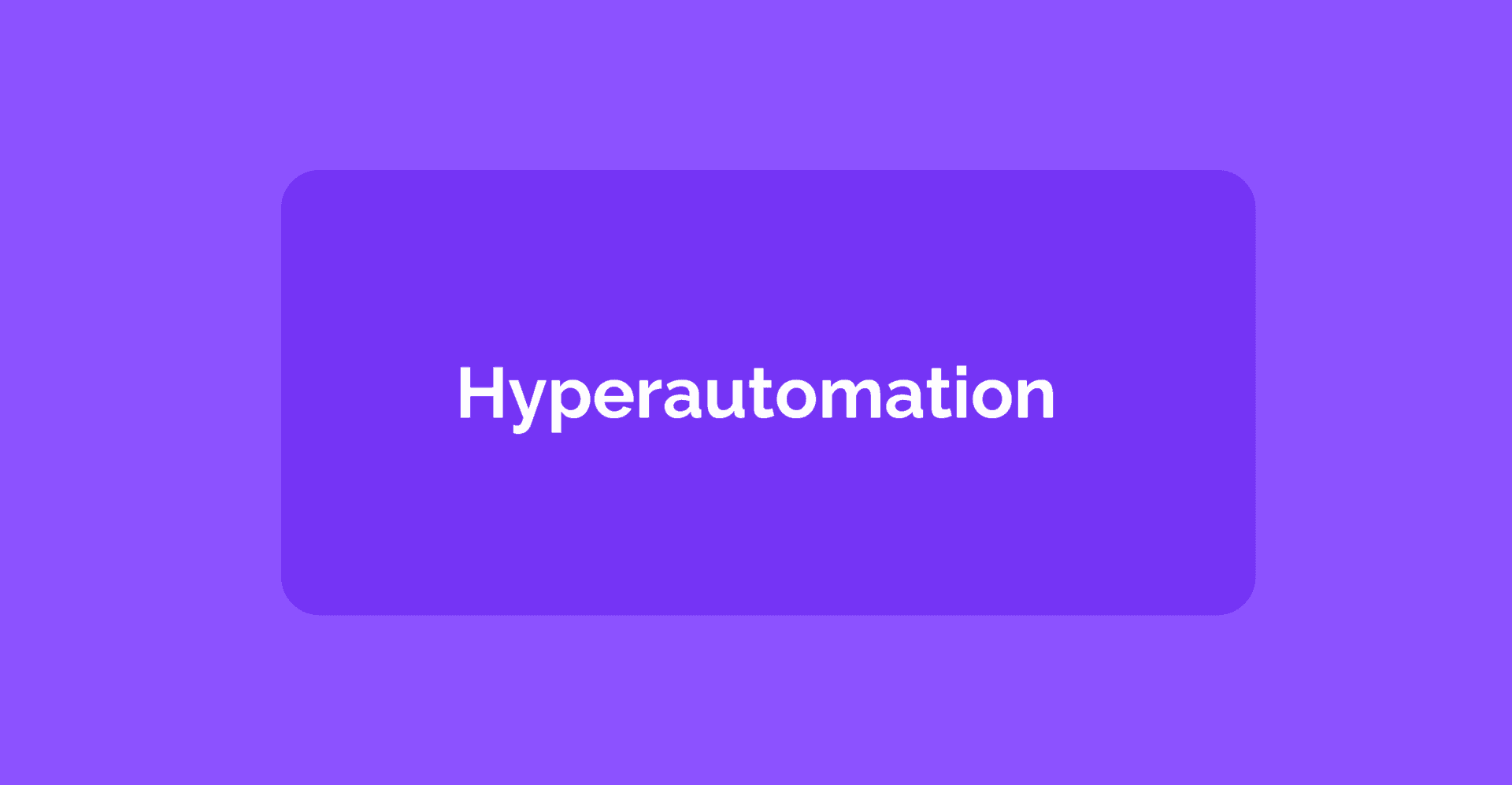Feb 23, 2022
Paul-Arthur
Jonville
Hyperautomation keeps coming back to the forefront of top trends. In 2020, the term was coined as a strategic trend. Hyperautomation was named an essential concept to overcome the following challenges: the workforce gap, reduced time to market, and the need to limit costs.
Hyperautomation follows another essential trend: Digital Transformation. Companies were already advised to embrace technologies to automate some of their tasks, reduce human interactions, and limit the overall cost of functioning.
Today, Digital Transformation is seen as an industry disruption factor. Companies are increasingly preparing for it. The pandemic accelerated the phenomenon further and surprised many of them.
However, the pandemic dramatically reinforced the factors presiding over the necessity of Digital Transformation, especially in cybersecurity and IT. Companies face a dramatic inelasticity of the human workforce, facing an ever-growing need.
This is where hyperautomation takes over Digital Transformation to further enhance your human resources capabilities.
Indeed, hyperautomation was coined right back in 2020 as a strategic trend. In 2022, it's even more the case. Companies need to improve the way they do business. They need to limit their spending to increase efficacy and efficiency. You need to handle tasks faster and sharper. This leads to an increasing need for automation. Errors are costing more and more money and reputation.
Hyperautomation will be a condition of survival instead of a mere option for the most advanced companies.
Now, the question relies on how to enable this strategy. When discussing hyperautomation, there's only a limited array of tools to help, among which are the new generation of SOARs, which are no-code, API-driven, and provide pre-built actions.
Below, we'll have a closer about
What's hyperautomation
How does it work
The benefits
Mindflow, as a no-code SOAR, fits perfectly as a hyperautomation-enabler
What is Hyperautomation
Simply put, hyperautomation enhances your employees' capabilities by automating work.
Today, most companies rely on legacy processes. These processes impede productivity because they are not streamlined, use old solutions that are not optimized, and are unconnected to the rest of the company's processes. This makes the technology stack a patchwork of solutions, suffering from inefficiencies and redundancies.
This leads to expensive and extensive issues. Companies end up with a burden, implying a loss of agility. They risk falling behind the competition curve compared to other companies that prioritize efficiency, efficacy, and agility.
However, competition and a new environment plead with companies to improve the way they're doing business, especially by embracing digital transformation. This goes by using streamlined, optimized, and connected processes. It paves the way for new, quicker, and less expensive ways to conceive work and tasks. They harness the benefits of new technologies in specific fields, such as Artificial intelligence, machine learning, and Robotic process automation in cybersecurity. In short, anything that can be automated should be automated.
But hyperautomation goes one step further than automation; it's a backbone. Indeed, it isn't about automating this task but rather an architecture relying on a core set of technologies. Doing so enables your employees to implement automation processes wherever they want. As such, hyperautomation is an architecture that widens the possibility of automation to potentially every tool and process. It's a process-agnostic tool.
Cybersecurity, business, and IT teams can collaborate and integrate the right tools and enhance the workflows. This way, your company will overcome the debt of relying on specific automation processes designed years ago that are unoptimized for your current needs. Thus, it breaks silos.
How does it work
According to Gartner, hyperautomation is an approach that enables your company to rapidly identify, vet, and automate as many processes as possible. To that end, the core infrastructure is built with the application of advanced technologies, including artificial intelligence (AI) and machine learning (ML), to automate processes and augment humans increasingly.
Achieving hyperautomation involves the orchestrated use of multiple technologies, tools, or platforms to build process-agnostic software, which, in essence, isn't limited to a particular set of use cases. This concept means that hyperautomation tools differ from Robotic Process Automation because they take the automation process one step further, enterprise-wide, at any scale.
They can be used in any organization and across multiple IT and business use cases. They connect technologies; as said before, they're the backbone of your digital architecture. From a loosely and approximately coupled set of technologies and ad-hoc automated processes, you're going to a connected and streamlined automation strategy at scale. This isn't about providing a packaged tool, another bundle solution, enabling you to do everything. No, by our approach, this is about bringing an agnostic element to your existing stack that will be at the center of it, allowing you to go for the best-of-breed solutions.
To explain the concept further, look at what are, to our eyes, the core components of a hyperautomation architecture:
Artificial intelligence and Machine learning to enable continuous learning with the data collected in your automation processes to improve your existing models dynamically
An event-driven software architecture (webhook, trigger) stands at the core structure of the solution. It differs from a traditional request-driven model by capturing, communicating, processing, and persisting events.
A Robotic Process Automation (RPA) engine to automate routine, repetitive, and predictable tasks through interactions designed to replace human actions and unlock better oversight control
Business process management (BPM) to enable control, collaboration, and improvement to align IT, cybersecurity, and business strategies
An Integration Platform as a Service (iPaaS): The API revolution provides unprecedented ways to connect the tools you are using. Next-generation platforms cannot be built without this in mind. Users need to have straight-out-of-the-box integrations.
A pre-built actions catalog to enable accessible, fast, and accurate automation. A new way and a core feature to build and automate your workflows
A No-code platform from which you orchestrate and automate. Low code is a halfway solution since it still carries parts of the initial issue, which are accessibility and technicity, which play an essential role in the skill barrier and technical debt. Yes, low-code is an incomplete technology when it comes to hyperautomation
Gartner is confident in the capacity of such a new generation of tools to take on the market and significantly impact how enterprises work. Even though they constitute a small part of the overall market, their impact will be significant. Gartner is projecting 54% growth in these process-agnostic tools. They also expect that by 2024, companies based on such architecture will lower operational costs by 30% by achieving operational excellence.
Indeed, this new architecture includes, in essence, tools that provide visibility to map your activities and processes, automate and manage content ingestion, seamlessly orchestrate work across multiple technologies, and deliver complex rule engines.
Benefits of Hyperautomation
Hyperautomation brings a wide array of benefits to your company, directly or indirectly. Direct benefits include faster and streamlined workflow processes. Indeed, we'll see that it has cascading effects at the company level as a new way of doing work.
In turn, these direct benefits empower your employees to do more in less time and in a better way. It results in a more robust engagement and better and more reliable architecture.
We're detailing more on some of the significant benefits down there:
Flexibility and scalability: Integrations and actions from a hyperautomation-enabling platform provide unprecedented flexibility in your work. The benefits of automation are broadened and made accessible to your teams, which aren't limited by the benefits of ad-hoc and out-of-date designed processes. This opens the path to scalability and flexibility of companies' operations at all business levels.
Improved employee productivity: the automation of time-consuming and complex tasks takes place without the need for lines of code. This is fundamental. It frees up the technical debt. Employees can design workflows when needed without the limitation of legacy work. This allows them to add more value to their roles and responsibilities. The creativity is unleashed and helps your employees be more productive, although needing less time and resources.
Visibility, Auditability, and Traceability: bringing a new and centralized way of automating tasks offers you better overall visibility of your processes, functions, and indicators. Workflows create digital representations of your operations. The automatic execution from a single platform also provides a centralized audit and traceability point. As a whole, hyperautomation-platforms improve your risk assessment.
Seamless integration of technologies: Hyperautomation-enablers continuously look to integrate technologies. Their architecture and attractivity are based on their integration catalog, allowing users to handle a growing set of processes and replace legacy systems. But integration alone isn't sufficient for a hyperautomation strategy. The no-code approach aims to implement more with pre-built actions. This way, teams can harness the full capacities of their tools with less effort and dynamism.
Improved Security: Leveraging analytical tools and hyperautomation capabilities leads to optimizing the defense strategy with streamlined and automated communications that can handle end-to-end cases or pinpoint tasks prone to human errors.
Workforce engagement: This next-generation technology changes the way teams work. It lowers the skill barrier to operating complex systems and enables quicker and more secure handling of use cases. Employees find hyperautomation a solid ally to alleviate some of their burdens, which escalates the quality of their work and improves their quality of life and the general engagement and satisfaction of working in your company. In cybersecurity, this is paramount, as the myriad of articles and statistics highlight the worsening of the quality of life of cyber professionals.
Mindflow as a hyperautomation enabler
Explaining that Hyperautomation is an essential concept is kind, but companies also need solutions. Here, Mindflow is the solution. We're helping you establish a solid base to start your hyperautomation transformation by providing you with the essential features needed to achieve it.
At its core, Mindflow is an RPA and event-driven software, thanks to specific triggers, webhooks, and scheduled features. Each workflow starts and is created on a no-code platform, integrating more than 200 connectors.
Moreover, Mindflow is pushing the no-code philosophy to its fullest by providing a rich pre-built actions catalog for each connector. Do you want to query a particular artifact from a type of mail coming into your Threat Intelligence database?
Look for the pre-built action in the Finder and connect the two steps without any line of code. This is accessibility in its purest form. Right now, Mindflow has more than 110,000 pre-built actions in its catalog.
Possibilities are growing exponentially, and limits are pushed further away every day. Explore Mindflow's use cases here.
Have a look, contact us.








